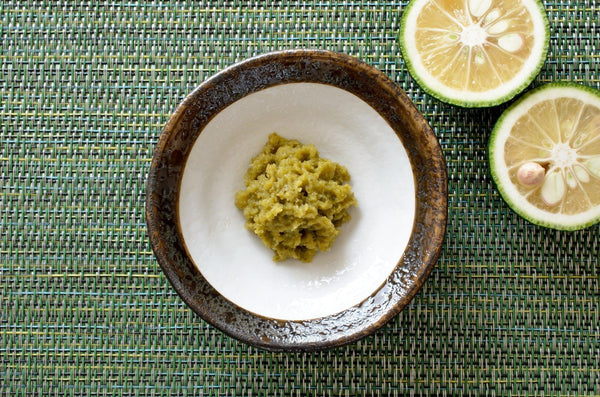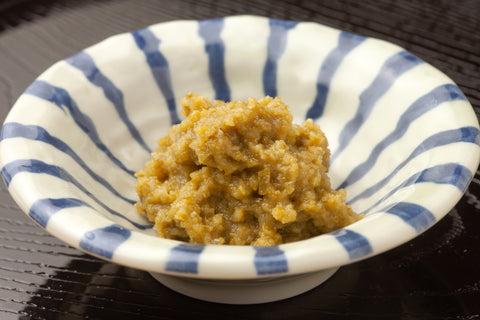
Jump to:
Are you bored with cooking with the condiments currently on your shelf? If so, and you haven’t tried Yuzu Kosho before, you might want to check it out. It is a paste that transforms everything it touches, including noodles, steak, fish, and even desserts, and becoming familiar with it is a great way to give your dishes some extra zip.
In this blog post, we shall look at what Yuzu Kosho is and what it tastes like, look at its history, consider the different varieties, the way it is been used, and consider some potential health benefits. We shall also look at how to make it and consider the best places to buy it if you would rather not make it yourself.
What Is Yuzu Kosho?

“Yuzu Kosho” is a combination of the words for “Yuzu” and “Kosho”. Yuzu is a citrus fruit native to Japan and China, the majority of which is produced in the Kochi region of Japan. Kosho means “pepper”, and, interestingly, although the kanji for Kosho (胡椒) normally refers to black pepper in Japanese, in the Kyushu dialect they refer to chili peppers, a main ingredient in the condiment. Yuzu Kosho is a seasoning paste that originated in Kyushu, in the south of Japan, and is a mixture of Yuzu peel, chili peppers, and salt that is allowed to ferment.
So, what does it taste like? Yuzu can be said to be somewhere between the sour, citrusy taste of lemon and the tartness of grapefruit. Accordingly, Yuzu Kosho can be described as combining the aromatic, tangy, and mildly tart taste of the Yuzu with the spicy punch of the chili peppers.
How Did It All Start?
There are various theories regarding the origins of Yuzu Kosho. One is that it was an ingredient used by the mountain priests of Mt. Hiko to make a secret medicine. Yuzu and chili peppers were handed down as medicines and non-perishable foods, and these were blessed by the priests and produced and sold as medicine. Yuzu came to Japan along with Buddhism and was cultivated as herbal medicine and for ornamental purposes. Chili peppers are thought to have been brought back to Dejima, a man-made island in the port of Nagasaki, by monks who entered the island during the Edo period (1603-1868) and who used their pharmaceutical skills to make what we now call Yuzu Kosho.
Another theory is that it originated in Hita, Oita Prefecture, also in Kyushu, as a tradition developed by Yuzu cultivators over multiple generations in family homes. It is likely that these theories both contain some truth, and that what is known as Yuzu Kosho today was developed independently from these two sources. There are records of it being sold as a product in 1950, by a company in Tagawa-gun, Fukuoka, but it is only in the last few decades that it has been heavily commercialized and made available in most supermarkets in Japan.
Different Types Of Yuzu Kosho

There are two main varieties of Yuzu Kosho: red and green. For red Yuzu Kosho, ripe yellow Yuzu are used, and these are combined with red chili peppers and salt. Compared to the green variety, it is said to be less spicy, and has a more mature, tart taste and strong aroma.
A great example of red Yuzu Kosho is this paste from Fundonkin. This product is completely additive-free, and by using a 5:1 ratio of Yuzu peel to pepper, it has a strong citrusy taste and the refreshing scent of Yuzu, while also allowing you to enjoy the kick and pungency of the pepper.
Green Yuzu Kosho, on the other hand, uses the Yuzu while they are still in their green, unripe state, and combines these with green chillis. Compared to the red variety, it is spicier and has a clear, fresh, sharp flavor.
This green Yuzu Kosho paste, also from Fundonkin, is an excellent example of this type. Also additive-free, this fermented condiment combines the original flavors of the unripe Yuzu skin and green chilis to give both the pleasant Yuzu aroma and fierce green chili pepper punch.
Traditionally, these combinations of Yuzu ripeness and chili color have been used when creating Yuzu Kosho, but you needn’t feel restricted by this. Later, in this article, we shall describe how to make Yuzu Kosho yourself, and this will enable you to mix and match to your heart’s content.
How Is Yuzu Kosho Used?

So, now we have had a look at what Yuzu Kosho is, how it started, and what the different types are, but what foods does it tend to be used with?
It is fair to say that people are waking up to the amazing versatility of this condiment and using it on a wider range of food all the time. Yuzu Kosho is useful whenever you want to add a combination of "saltiness" + "spiciness" + "Yuzu aroma" to your dishes!
A traditional favorite is using it with Nabe (Japanese hot pot) to add an alternative flavor to the dipping sauce (find out more about Nabe here). The citrus flavor is also said to cut through grease well, making it a useful ally when eating fattier meat cuts. It can be used with popular Japanese cuisine such as Tempura and Yakitori, or in place of Wasabi when eating sashimi, as well as Western fare such as pasta (where Yuzu Kosho can be used as a substitute for pesto sauce) or with salads.
You don’t need to stop at savory dishes either. The citrusy nature of Yuzu Kosho means that it gives a delicious accent to Western desserts, such as vanilla ice cream and cheesecake, as well as Japanese varieties, such as Dango dumplings.
Are There Any Health Benefits To Yuzu Kosho?
Yuzu Kosho is composed of two healthy ingredients, Yuzu and peppers. Yuzu is rich in vitamin C, helps improve blood flow, and is considered generally good for health. Chili peppers contain capsaicin, which helps keep your metabolism active.
While these are clearly health benefits, we should perhaps note that typically you would only use a teaspoon or so of Yuzu Kosho with each meal, so unless you are taking copious amounts of it (at which point the sodium levels would be a concern), the health benefits are likely to be negligible.
Can You Make Yuzu Kosho At Home?

It is relatively easy to make Yuzu Kosho yourself. The only three ingredients you will need are chili peppers (red or green), Yuzu zest (from ripe or unripe Yuzu), and salt. Once you have made a few batches, you can adjust the ratios of ingredients depending on whether you want it more or less citrusy, spicier or less spicy, and saltier or less salty, but we recommend you start with the ratio 80:80:15, with salt being the smallest quantity ingredient.
Steps for making Yuzu Kosho
- Remove the stems and seeds from the chilis. Cut them finely and grind them using either a food processor or, if you have it, a mortar and pestle.
- Mix the chili paste with the zest of the Yuzu and the salt.
- Ferment by leaving the paste in an airtight container for about a week (optional)
Options For Buying Yuzu Kosho
As mentioned above, it is quite easy to make Yuzu Kosho and it allows you to experiment with different ratios and combinations of pepper and Yuzu ripeness varieties. However, unless you are making large amounts of it, it is unlikely to be cost effective, and you may simply not have the time to make it yourself. Fear not! Yuzu Kosho is now available in nearly all supermarkets in Japan and many online shops. A great place to start is the Japanese Taste website, using the recommendations mentioned in the “Different Types of Yuzo Kosho” section above.
Storing Yuzu Kosho
When unopened, Yuzu Kosho can be stored at room temperature for a long time. After opening it, it is advisable to keep it in the freezer, and only use what you will need each time. The salt in the yuzu kosho keeps it from freezing solid, so you can use it right away even if it is stored in the freezer.
Yuzu Kosho – The Condiment For All Occasions

Yuzu Kosho is definitely a condiment that is gaining popularity in Japanese kitchens and dining tables. The refreshing blend of fruitiness, saltiness, and spiciness gives you something that you cannot find anywhere else, and especially if you make it yourself, there is a wide range of combinations of the above elements that you can try.
Whether you are concocting your own version or just buying it in the store, go ahead and take the plunge! If you give free rein to your imagination and try using Yuzu Kosho with all kinds of sweet and savory food, you are bound to hit on some stellar combinations. If you find something good, be sure to let us know in the comments.


0 comments